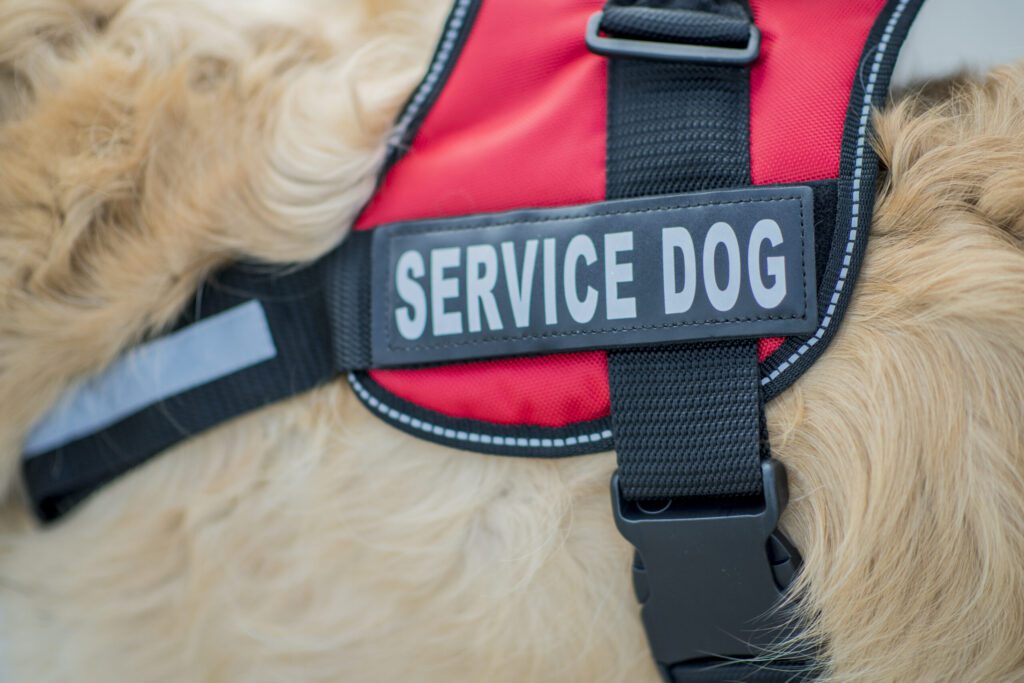Rights, Best Practices, and Etiquette
by CELÉSTE JO WALLS
You have heard of them: guide dogs for the blind, PTSD support dogs for veterans, seizure response dogs, alert dogs for the hearing impaired, diabetic alert dogs, wheelchair assistant dogs, and more. You may have seen them in department stores, at theme parks, in restaurants, and even on airplanes. They are more than just dogs; they are four-legged medical service members of our society. To their handlers, they are lifesavers, and the work these service dogs do is critical to their owner’s safety and long-term quality of life.
Due to their life-enabling importance, public access for these service dogs is not only necessary but essential. Unfortunately, there are a lot of misconceptions about public access for these members of our society, as well as how family, friends, and strangers should (and should not) interact with these special animals. Service animal trainers and handlers are on the front lines of challenges posed by misconceptions. Take Stephanie and Mitch Bowen, of Bowen Elite Service Dogs, as an example. “One of the biggest misconceptions pertaining to service dogs in public is how they are to be treated by others,” Stephanie says.
Don’t Distract a Service Animal
“While training the dogs that are in our program in public venues, we have several people approach the dogs in different ways. The first, and unfortunately the most popular, way is to invade the dog’s space and reach out and pet them without asking us,” Stephanie explains. “People tend to be inconsiderate that these working dogs do not know them and may have a reaction toward strangers. The dogs we train will not be ‘ruined’ by someone politely touching them. In fact, they won’t react much at all. But, the point is that people don’t think about the effects their interactions may cause.”
Communicate With the Handler First
“The correct way to approach a service dog is to politely communicate with the handler,” she says. “They may make compliments about the dog and even ask questions, but they should not be speaking to the dog. This would be a distraction, on top of all the other distractions they are dealing with at that moment. Luring a service dog’s attention away from the handler could be detrimental to the dog fulfilling its duties to its person, which could have catastrophic results.”
Emotional Support Animals Are Not Service Animals
So how can you tell the difference between a service animal and a regular pet? Title II and Title III of the Americans with Disabilities Act, which was revised in 2010, defines a service animal as “any dog that is individually trained to do work or perform tasks for the benefit of an individual with a disability, including a physical, sensory, psychiatric, intellectual, or other mental disability.” Under this same regulation, it is defined that “emotional support animals, comfort animals, and therapy dogs are not service animals.” Therefore, regular pets and emotional support animals and their owners do not have the same level of public access as a service animal and his handler.
“At Bowen Elite Service Dogs, we believe that there is a definite difference between service dogs and emotional support dogs. Service dogs are to give assistance to people who have had a medical diagnosis or a significant event/situation that creates a need for help from a working dog,” Stephanie says. “Emotional support dogs have the purpose of creating a positive atmosphere for their owner when they need it. The training that each classification goes through is entirely different.”
Is There Any Place Where a Service Animal Is Not Allowed to Go?
The ADA requires that all state and local governments allow admission of service animals and their handlers in all areas where the general public is allowed to be. “Service dogs cannot be denied access anywhere that their handler is allowed to enter,” Mitch says. “So, if a business or venue is denying access to them, they may face very serious repercussions as a result.”
However, it is the responsibility of the handler to supervise the service animal while in public spaces. According to the ADA National Network, if a service animal is behaving in an unacceptable way and the handler does not have control, the business or establishment does not have to allow access on its premises. “Service dog handlers should have a large focus on the well-being and situational awareness of their dog,” Stephanie says. “If the dog is reacting to things around them and not responding to the handler’s commands, it is either not a service dog, or it needs to go through some more training to overcome its tendencies and behaviors.”
So, remember, if you see a service animal and his handler in a public space, keep these insights at the forefront of your mind, which will help our four-legged heroes do their work uninterrupted for their handlers who need them.
ABOUT THE AUTHOR: Celéste Jo Walls writes on topics related to her professional and personal expertise, which includes mortgage news, medical topics related to Type 1 Diabetes, and medical service dogs. She is a Senior Loan Officer at American Residential Mortgage as well as a wife and mother of five children, two of them Type 1 diabetes warriors, who are soon-to-be handlers of a diabetic alert dog. You are welcome to follow their medical service dog journey at Facebook.com/team-t1-tails.
